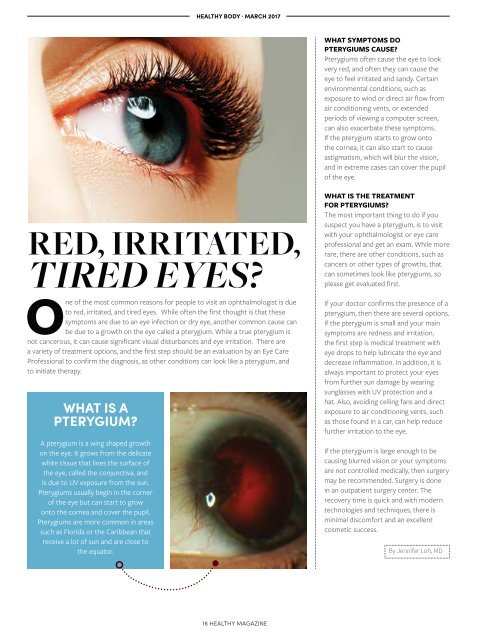MARCH 2017 MIAMI
You also want an ePaper? Increase the reach of your titles
YUMPU automatically turns print PDFs into web optimized ePapers that Google loves.
HEALTHY BODY · <strong>MARCH</strong> <strong>2017</strong><br />
WHAT SYMPTOMS DO<br />
PTERYGIUMS CAUSE?<br />
Pterygiums often cause the eye to look<br />
very red, and often they can cause the<br />
eye to feel irritated and sandy. Certain<br />
environmental conditions, such as<br />
exposure to wind or direct air flow from<br />
air conditioning vents, or extended<br />
periods of viewing a computer screen,<br />
can also exacerbate these symptoms.<br />
If the pterygium starts to grow onto<br />
the cornea, it can also start to cause<br />
astigmatism, which will blur the vision,<br />
and in extreme cases can cover the pupil<br />
of the eye.<br />
RED, IRRITATED,<br />
TIRED EYES?<br />
One of the most common reasons for people to visit an ophthalmologist is due<br />
to red, irritated, and tired eyes. While often the first thought is that these<br />
symptoms are due to an eye infection or dry eye, another common cause can<br />
be due to a growth on the eye called a pterygium. While a true pterygium is<br />
not cancerous, it can cause significant visual disturbances and eye irritation. There are<br />
a variety of treatment options, and the first step should be an evaluation by an Eye Care<br />
Professional to confirm the diagnosis, as other conditions can look like a pterygium, and<br />
to initiate therapy.<br />
WHAT IS A<br />
PTERYGIUM?<br />
A pterygium is a wing shaped growth<br />
on the eye. It grows from the delicate<br />
white tissue that lines the surface of<br />
the eye, called the conjunctiva, and<br />
is due to UV exposure from the sun.<br />
Pterygiums usually begin in the corner<br />
of the eye but can start to grow<br />
onto the cornea and cover the pupil.<br />
Pterygiums are more common in areas<br />
such as Florida or the Caribbean that<br />
receive a lot of sun and are close to<br />
the equator.<br />
WHAT IS THE TREATMENT<br />
FOR PTERYGIUMS?<br />
The most important thing to do if you<br />
suspect you have a pterygium, is to visit<br />
with your ophthalmologist or eye care<br />
professional and get an exam. While more<br />
rare, there are other conditions, such as<br />
cancers or other types of growths, that<br />
can sometimes look like pterygiums, so<br />
please get evaluated first.<br />
If your doctor confirms the presence of a<br />
pterygium, then there are several options.<br />
If the pterygium is small and your main<br />
symptoms are redness and irritation,<br />
the first step is medical treatment with<br />
eye drops to help lubricate the eye and<br />
decrease inflammation. In addition, it is<br />
always important to protect your eyes<br />
from further sun damage by wearing<br />
sunglasses with UV protection and a<br />
hat. Also, avoiding ceiling fans and direct<br />
exposure to air conditioning vents, such<br />
as those found in a car, can help reduce<br />
further irritation to the eye.<br />
If the pterygium is large enough to be<br />
causing blurred vision or your symptoms<br />
are not controlled medically, then surgery<br />
may be recommended. Surgery is done<br />
in an outpatient surgery center. The<br />
recovery time is quick and with modern<br />
technologies and techniques, there is<br />
minimal discomfort and an excellent<br />
cosmetic success.<br />
By Jennifer Loh, MD<br />
16 HEALTHY MAGAZINE

















